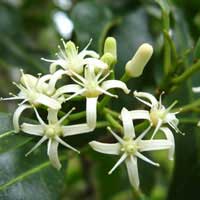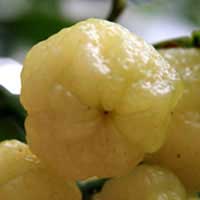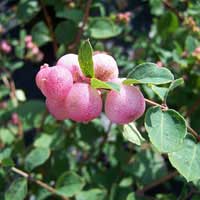 Full List of Fruits
Full List of Fruits  White aspen
White aspenWhite aspen Fruit
Scientific name - Acronychia oblongifolia
Acronychia oblongifolia, having its roots in the Rutaceae (citrus) family is a small to medium sized rainforest tree thatís indigenous to eastern Australia. Commonly recognized as white aspen they are dispersed from Queensland to Victoria. It grows as a shrub or medium sized tree and can reach a height of 27 m (90 ft). Even though it can have fine wrinkles, pustules or fissures, the trunk is smooth and dark brown in color. With a contradicting leaf arrangement on the stem, they measure 3-12 cm (2-5 in) long and 1-5 cm (0.4-2 in) wide. They are oblanceolate, fibrous, dark green and fragrant.
![]() Nutritional Value of White Aspen
Nutritional Value of White Aspen
| Nutrition Facts | |
| Calories | 90 |
| Fat | 0.5g |
| Carbohydrates | 20.3g |
| Fiber | 2.3g |
| Protein | 1.4g |
| Sugar | 0.4g |
| Sugars | 25.0 g |
| Vitamin A | 10% |
| Vitamin B6 | 8% |
| Vitamin C | 6% |
| Calcium | 4% |
| Iron | 8% |
| Magnesium | 6% |
| Phosphorus | 4% |
| Potassium | 8% |
| Zinc | 6% |
There are several known uses for the wood of the white aspen, fairly strong, they are soft and has low flammability, hence used for making matches and paper. Its low flammability aspect makes it safer to use than most other wood types. Occasionally called excelsior, shredded aspen wood is used for packing and stuffing. Seeing that, the wood lacks the phenols coupled with pine and juniper, it is used as animal bedding (which is thought to cause respiratory system ailments in some animals).
With that said, the wood is also known for its usage for the interiors of a sauna, however they are heat-treated. Despite the fact that standing trees at times have a propensity to become rancid from the heart outward, the dry timber conditions very well, becoming silvery-grey and opposed to rotting and warping, and has by tradition been used for countryside construction in the northwestern regions of Russia (especially for roofing, in the form of thin slats).
![]() Health Benefits of White aspen
Health Benefits of White aspen
Leaf buds and leaves of white aspen can heal various burns and irritation. Seeing that the tree is known to contain a chemical compound called salicin which shares the same qualities of aspirin, they are said to have anti-inflammatory properties.
Known to help bladder and prostate problems, they can also help alleviate various types of aches which also include joint pains (rheumatism), back pains (sciatica), and nerve pains (neuralgia).
Bark and leaves of the tree are used to make a decoction which is said to treat mild urinary tract infections; however, the inner bark of white aspen has laxative effects
Not only with white aspen, but with all other products, it is always good to know the side effect it brings. As with aspen, sensitive skin people might get skin rashes as they come in contact with the tree. Any form of aspen when combined with alcohol is said to scale up the risk of bleeding in the stomach and intestines, hence if you are using any form of aspen, avoid drinking alcohol. People who are prone to allergic symptoms of aspirin should stay away from using aspen because they are said to contain a chemical similar to aspirin. Pregnant and nursing women should also stay away from this. Seeing that, salicin can worsen the effects, diabetes patients should avoid this. People who are suffering from gout, stomach ulcers, blood disorders, liver diseases or kidney diseases should also avoid aspen.
White aspen is a fast-growing species of deciduous tree native to North America. It is popularly cultivated for its unique features and aesthetic appeal, particularly its white-colored bark and distinctive, lime-green foliage. It is a hardy species, tolerant of a wide range of soil types, and can thrive in hot, dry climates.
When growing white aspen, it is important to select a site with plenty of sun and well-drained soil. Planting should be done in early spring or late fall, and the tree should be given a good amount of space to spread its roots. If planting multiple trees, be sure to leave enough room for them to grow.
White aspen does best with regular watering, especially during dry periods, and should be fertilized once a year in the spring. Pruning should be done in late winter or early spring to remove dead branches and shape the tree.
White aspen can be propagated from cuttings taken in late summer. Cuttings should be taken from the side of the tree, and should be planted in a container filled with moist soil, then kept in a sheltered spot with indirect sunlight.
In addition to providing a unique aesthetic, white aspen is a valuable species for wildlife. It provides food and shelter for a variety of birds, small mammals, and other wildlife. It is also popularly used in landscaping and as a windbreak.
Frost tender when young, they are moderately readily cultivated in a well-drained soil and bright aspect, and benefits from extra water and fertilizer. In general, they are propagated by seed or cutting.


















